Your logo expresses your organisation’s identity. It marks your products as… yours. It tells potential customers what you offer and what type of service you give. And it helps potential clients remember you. The wrong logo can undermine your confidence, even if your offering is great. It can leave you feeling uncomfortable doing business. A bad logo can attract the wrong type of customer or scare off the right kind. So your logo is a key piece of your business infrastructure.
Getting to know your business
One of the reasons I like developing websites for West Kent clients is that I can meet them face-to-face and go through a discovery process. Our discovery can be done online, but I value the opportunity to get to know clients and their businesses in the real world. During a discovery I ask all kinds of unlikely questions about the client’s work and their values. This helps me to build a picture of the organisation, the market and what the client needs from their branding and website.
What type of logo do you need?
There are several different kinds of logo, each with its own advantages and disadvantages. It can be difficult to know whether you need a lettermark or a wordmark or something more pictorial. But a good designer can help you to make that decision. If you want to know more, there’s a great discussion about the different types of logo over at 99designs.
Brief the designer
Once I’ve got to know about your needs, I can instruct our designers to put together a logo.
The brief I give to the designer includes information about:
- the organisation (what it does)
- who it serves (the ideal customer and what problems they have)
- the client’s personal preferences (colour palettes and imagery, for example)
- how the logo is likely to be used (on a website, on social, on products).
I also tell the designer exactly how the client wants their company name presented. Are there hyphens? Is an ampersand (&) acceptable or do they prefer the word ‘and’? Some businesses have strong feelings about this; others not so much. But it’s a good idea to make a decision at an early stage about how an organisation’s name is to be presented.
The big reveal
We’ve found that clients like a choice of two or three designs, so that’s what our designers provide. We take your feedback, make changes and come back with a design that feels just right for the organisation. It can then be used to inform other design choices, such as colour palettes, fonts and proportions on the website.
Top tip: look after your logo files
The designer will send you your logo files. Keep these safe, even the formats that you can’t open. You’ll need them when the time comes to get stationery, brochures, business card and vinyls printed. You will also need them when you order branded merchandise, or if you want branding on your fleet.
Can we help with your logo and branding?
It is quite possible to start doing business without a logo and without branding. It can actually be helpful to do this. If you’ve got experience of selling your product or service then you are more likely to have a clear idea about the values that lie behind your offering. This self-knowledge will make your branding journey smoother.
And many of our clients choose to freshen up their branding and logo while they launch their new website, too.
So whatever stage you’re at, talk to Eonic.
